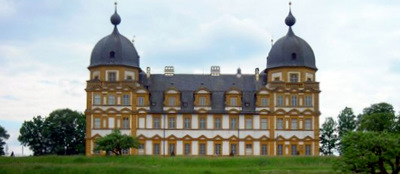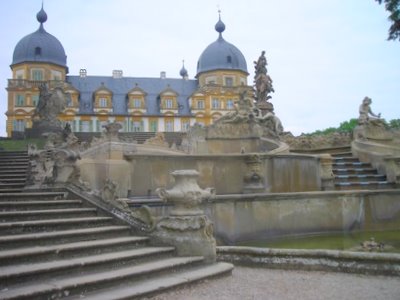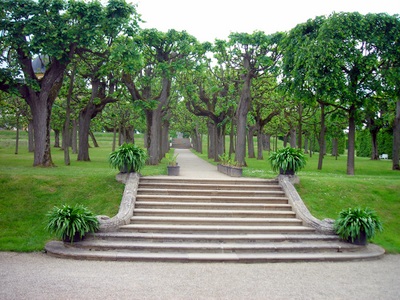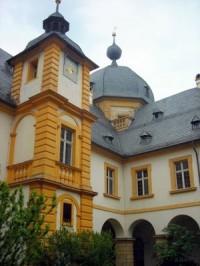When traveling around Franconia (Northern Bavaria), be sure to visit the impressive Schloss Seehof, located just five kilometers from Bamberg in Memmelsdorf. The Baroque structure was constructed in the late 17th Century as the summer residence and hunting lodge of the prince-bishop Marquard Sebastian Schenk von Stauffenberg. Four domed corner towers mark the symmetrical building. The extensive gardens, fountains and sculptures were added in later centuries by other prince-bishops who resided in the castle.
 After secularization, the castle came under private ownership and fell under neglect during the 19th and early 20th Centuries. The original furnishings were sold off and the elaborate gardens decayed. In 1975, the Bavarian government purchased the property and the castle and gardens underwent extensive renovations, reopening to the public in the 1990s. Some of the original furnishings and artwork of the palace were located and placed on exhibit.
After secularization, the castle came under private ownership and fell under neglect during the 19th and early 20th Centuries. The original furnishings were sold off and the elaborate gardens decayed. In 1975, the Bavarian government purchased the property and the castle and gardens underwent extensive renovations, reopening to the public in the 1990s. Some of the original furnishings and artwork of the palace were located and placed on exhibit.
Visitors to the palace first come across the Orangery building, an extension of the original Memmelsdorf gate. The central gate was constructed in the early 18th Century in the Rococo style; white stucco with orange accents. Greenhouses were later added to flank the gate to shelter the exotic plants owned by the prince-bishop during the winter months. Part of the Orangery now serves as a museum for the artist Ferdinand Tietz, who worked on several commissions for the palace and gardens.
 One of the most unique qualities of the Schloss is the massive fountain or cascade located behind the main building. The piece was sculpted by Ferdinand Tietz and depicts Hercules and some of his twelve labors. Construction began in the 1760s and in addition to the large fountain, an underground tunnel was required to supply a constant source of water to the sculpture.
One of the most unique qualities of the Schloss is the massive fountain or cascade located behind the main building. The piece was sculpted by Ferdinand Tietz and depicts Hercules and some of his twelve labors. Construction began in the 1760s and in addition to the large fountain, an underground tunnel was required to supply a constant source of water to the sculpture.
There are currently nine rooms of the palace accessible to visitors. Many contain the original wooden mosaic floors, arranged in interesting geometric patterns. The ballroom or White Hall contains a well-preserved ceiling fresco painted by Guiseppe Appiani, depicting Cupid and other angels. All of the rooms have been restored to resemble life in the 17th and 18th Centuries, with furniture, artwork, light fixtures and other details from the respective periods.
 Tours of the interior are given in English and German. Visitors can view the period-decorated rooms and inner courtyard. The castle is open to the public Tuesday through Sunday from April to October and closed during the winter. Guided tours are offered daily from 9:00 a.m. to 6:00 p.m. The castle gardens are open the same months as the main building, but can be toured at no cost. The cascade’s water display is shown every hour from 10:00 a.m. to 5:00 p.m. from May through October. It is worth watching the water dance among the sculptures while visiting the palace.
Tours of the interior are given in English and German. Visitors can view the period-decorated rooms and inner courtyard. The castle is open to the public Tuesday through Sunday from April to October and closed during the winter. Guided tours are offered daily from 9:00 a.m. to 6:00 p.m. The castle gardens are open the same months as the main building, but can be toured at no cost. The cascade’s water display is shown every hour from 10:00 a.m. to 5:00 p.m. from May through October. It is worth watching the water dance among the sculptures while visiting the palace.
 In the summer, the castle hosts classical music concerts. In early June a chamber music festival, known as Spring in the Schloss Seehof, is held. A second music festival, Sommerserenaden Schloss Seehof, takes place in August.
In the summer, the castle hosts classical music concerts. In early June a chamber music festival, known as Spring in the Schloss Seehof, is held. A second music festival, Sommerserenaden Schloss Seehof, takes place in August.
The Schloss Seehof can be accessed by car or by bus from Bamberg. There is a small café at the palace located in the Orangery. This romantic building with its idyllic surrounding gardens is well worth a visit. Bring a picnic and make a day of it, touring the house museum, watching the waterworks display at the cascade and strolling amidst the perfectly manicured lawn.


Comments